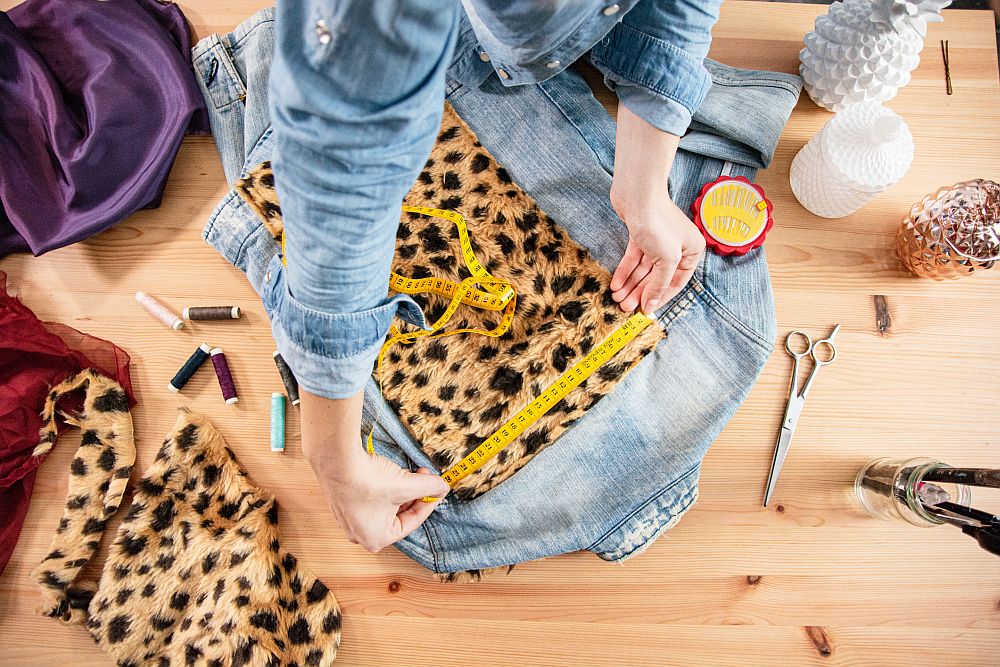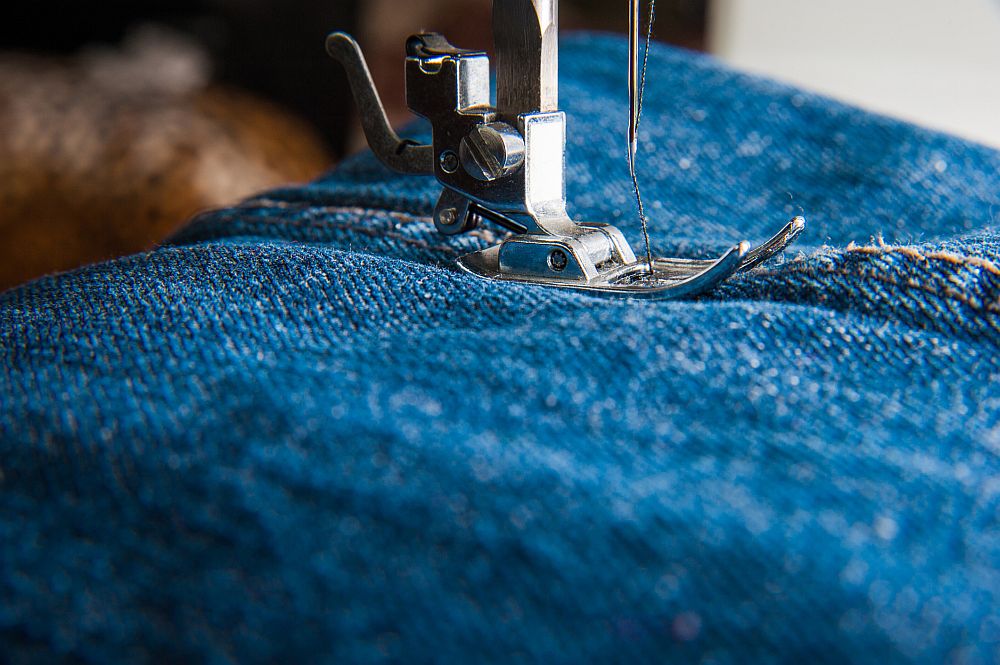Why are denim jackets so expensive, anyway? While some won’t hesitate to pay the premium, it stills baffles many that some seemingly simply denim jackets are so costly. Granted, this iconic casual-smart outerwear is smart, stylish, sturdy and versatile, checking off quite a few boxes with a single humble garment.
View in gallery
Getting the best denim jackets today involves a lot of research and maybe even some trial and error. But to understand why this piece of clothing can sometimes cost an arm and a leg, you need to appreciate the various factors that go into its production.
Sounds overwhelming? No need to worry, because in this article we’ll take you through the various steps involved in making denim jackets, and give you a glimpse of why they are so pricey after all.
First, A Brief History of Denim
Denim is a cotton-based material that’s known for its durability and suitability for rugged wear. It became mainstream after gold hunters fell in love with this cloth that absorbed the rough and tumble of life in the wild west.
In 1873, Jacob Davis and Levi Strauss introduced denim to the general populace. They made clothing out of fabric known as “serge de Nîmes” from Nîmes, France. The fabric’s name eventually shortened to just “denim”.
Some General Considerations of the Denim Material
View in gallery
Denim’s availability and price directly depend on the economics of cotton. This, in turn, depends on the vagaries of weather and other factors. This alone gives us a baseline consideration for why denim jackets are so expensive.
After growing and picking the cotton, manufacturers select the cotton with longer fibers suitable for weaving. It then undergoes a thorough cleaning and combing process. Next comes spinning, where the raw material transforms into a twill weave, featuring he hallmark diagonal ribbing fabric pattern we associate with denim. Ribbing climbing diagonally upwards and to the right constitutes “right-hand” twill, with leftward twill sharing a similar naming convention. The number of yarns as well as the depth of the twill determine how bold the pattern is.
Warp yarns are colored indigo, while weft lines are neutral or light-colored. This arrangement gives the denim fabric two tones: blue on the outside and light-colored on the inside. The next step is dying, usually with indigo, to give the denim that signature blue-jeans blue. This is actually a two-tone effect, with indigo warp yarns on the outside in conjunction with light neutral weft lines on the inside. Finally, there’s any mixture of finishing processes to determine the final look of your denim jacket.
About raw, selvedge, and synthetic denim
Raw denim isn’t just marketing jargon; it refers specifically to unadulterated cotton fabric. Garments made in this way are usually not washed for at least six months to a year. This makes the stiff material crease and folds in contours that naturally follow the wearer’s body shape and lifestyle. In essence, raw denim offers an item of personalized clothing that is molded after the wearer’s body.
In today’s world, however, most denim outfits have been combined with other synthetic and natural fibers to improve wearability and other traits (including price). There are also methods of preparing the fabric for use in clothing, such as selvedge, which adds both strength and a touch of style to the bottom line on your denim clothes.
Processes that Make Denim Jackets so Expensive
The processes expensive denim jackets have to go through before they land in a store and eventually your closet play a big role in determining their selling price. So, how complex is denim processing? Is it mechanized and automated, or does it involve skilled workers?
With some of the intricate procedures carried out on the denim jacket, you could argue that what you are purchasing is not just an item of clothing but a work of industrial art.
Let’s delve deeper into the various factors involved in creating denim jackets, and how they affect their final pricing.
Hiring Skilled Workers
View in gallery
The cost of hiring workers to create your denim jacket will have a direct bearing on its final cost. Using skilled workers, especially in the selvedge and distressing stages, will affect its pricing.
In countries where the process of making your denim jacket involves machines in an assembly line arrangement, attention to detail is unlikely. Therefore, the cost may not be too high. But hand-made, limited edition jackets will cost more–often a lot more. It’s not just the cost of labor, either; people are generally happy to pay more for fair-wage, guilt-free clothing–and the market is all too happy to capitalize on that.
Adding Color
Denim’s hallmark blue color stems from the indigo dye in its yarn. Of course, in today’s world, denim can come in a host of colors, usually from sulfur-based dyes.
However, the indigo hue is still by far the most popular color for denim garments, jackets included. These days, indigo dye is mostly synthetic, although more costly indigo from fermented plants is also available. It’s eco-friendly, but it also pushes up costs and can be a major contributor as to why denim jackets are so expensive.
Attention to Detail: Selvedge
View in gallery
There is an old saying that goes, “cut your coat according to your cloth.”
In the denim world, attention to detail is another factor that determines the cost of your denim jacket. One of these details is the selvedge, which is a modification of “self-edge.” This is a tightly woven band of cloth meant to prevent the weave from unraveling. But, it’s also come into its own as a desirable aesthetic touch in denim clothing.
To create selvedge, one needs a traditional shuttle loom that creates a narrower band of denim compared to the conventional dimensions. It uses a continuous thread that is tightly woven, resulting in a fabric that does not fray. This highly desirable fabric does, admittedly consume and waste thread in manufacturing. Thus, the price goes up to compensate for the loss.
In today’s world, creating denim usually involves 12 to 14 machines. Mass production, therefore, becomes necessary to recoup the investment in equipment. Most of this process is outsourced to Asian countries, where the labor laws are not as strict as in the USA. This does lower the price to the consumer, but at the cost of quality and concern over working conditions.
Adding Other Fibers to Cotton
100% cotton is the purist’s ideal for denim. However, before raw denim is broken in (by wearing it for a long time before washing), it is rigid and uncomfortable.
To make the fabric more malleable, most denim makers will add synthetic fibers to the cotton base. A small amount of polyester will make the denim more resistant to wear. Usually, though, this neither adds to nor detracts from the general cost of making a denim jacket.
On the other hand, stretch fibers do drive up the price. Lycra and spandex are the fibers of choice, both of which snap back to their original position after stretching. This will keep a garment looking as fresh at the end of the day as it did in the morning.
The more stretch fiber there is, the more expensive a denim jacket is going to be. Another consideration is how manufacturers incorporate stretch fibers into the the fabric.
(The downside with stretch fibers is that they often give your denim fabric an unattractive, synthetic sheen. Furthermore, the indigo dye does not attach well to the stretch fabric. To clear these hurdles, manufacturers embed stretch fibers within the fabric’s core, then surrounding it with denim fibers. The result is a fabric that looks like normal denim, but with the stretch fabric’s desirable characteristics.)
Sewing
View in gallery
Still wondering why denim jackets are so expensive? Consider the methods of sewing your garment together.
A flat-felled stitch, for example, makes a flatter seam than one that is made with an overlock machine. This offers a clean look that is not replicated by the overlock or serger machine. And since the flat-felled machine is expensive, those costs are passed on to the customer.
What’s more, the number of stitches per inch (SPI) on a denim jacket affects its quality, durability, and therefore its cost.
Additions
Don’t forget about the buttons and zippers adorning denim jackets. While they will not count much in the garment’s overall price, it is important to get the quality right to justify your purchase. The gold standard in zippers is YKK, both for style and for durability. Buttons will normally have the logo of the company on them. If no logo is present, this is a sure sign they’re generic and possibly of lower quality.
Another item that is worth looking at is the artistry of the grommet on your jacket. Grommets are small studs that are placed on the edges of the pockets of some denim jackets. If the fiber is loose around the grommets, it could be an indicator of poor workmanship.
Finishing and distressing
Distressing offers a final touch that can drastically alter the look (and cost) of your denim jacket. Its goal is to simulate years of honest wear and highlight your best features without the commitment. Distressing is the most popular form of finishing, but definitely not the only one. For example:
- Sanforizing exposes the denim to water or steam, making it shrink. Sanforized denim is thus resistant to shrinkage later when the buyer washes it for the first time.
- Crushed denim comes through a specific weaving process, which gives the fabric a permanently wrinkled look. Manufacturers enhance the effect by controlled-bleaching or stone washing.
- Acid-wash denim is a result of rubbing the fabric with a chlorine bleach-soaked pumice stone. Also known as marble wash, this method creates an attractive contrast in the fabric as the bleach and rubbing fade the indigo dye.
- Ecru denim skips the indigo dying process altogether, thereby retaining the natural color of the cotton fibers.
- Thermo denim is also known as double denim. In this process, manufacturers glue lightweight fabric to the inner side of the denim, which offers comforting insulation.
- Waxed reverse denim, as the name suggests, has a coating on the outside, giving it a water-resistant quality.
- Sandblasted denim is the result of blasting denim with sand at high pressure, creating a worn-out effect.
A cost-increasing process worth noting is the whiskers on your denim jacket. Whiskers is the term used for the tiny lines that appear along the zippers’ length if the denim garment is worn long enough. To create this without the long wait for them to form naturally, most manufacturers will use lasers. Others will use skilled workers to sandpaper the material. The latter process will add significantly to the price of your denim jacket.
Reasons Why You Should Buy Expensive Denim Jackets
After addressing all these factors that explain why denim jackets are so expensive, some people may still not be sold. And you know what, if you don’t want to pay more than the bare minimum, that’s okay.
How much you are willing to spend on clothes, ultimately depends on a number of factors–and not just the fact that it was costly to produce the item. Your lifestyle, your reason for buying a denim jacket, and how you feel about the attire are among the core considerations when deciding whether to splurge or buy budget.
Since today our focus is on the pricey denim jackets, we’ll give you some pointers to help you develop an open mindset as to why going premium can actually be better.
#1. Paying More Usually Means Getting Higher Quality
View in gallery
We’re not trying to bash all cheaper denim jackets as being altogether low quality. But, it is safe to generally assume that the higher the price point, the better the quality.
After all, making something right actually takes time and money. And by “right”, we mean it looks good and wears hard. Thus, unless you’re only going to be wearing your denim jacket occasionally, you should definitely consider “paying nice to avoid paying twice” down the road.
#2. Invest in Something You can Mix and Match
If you have a high-cost jacket in your closet that makes you stand out whenever you put it on, then you’d probably want to wear it as often as you can.
Why? Well, firstly, you want to make the most out of it since it cost you a small fortune to acquire. But secondly and more importantly, premium denim jackets are often the brainchildren of experienced designers, and will offer a sartorial edge to a wider variety of outfits.
So, by buying an expensive denim jacket, you can actually get more out of it than just a simple low-priced piece. This leads us to our next point.
#3. You’ll Get More Use out of an Expensive Denim Jacket
It’s not uncommon to find people with so many clothes in their closets that they just don’t wear. And with $20 jackets, there’s no real sting in keeping your denim tucked away for a rainy day. And since the item may not be so exquisite, you’ll probably have the urge to go out and get another whenever a special event is coming up.
Not so with expensive clothing like a premium denim jacket. Having paid top dollar for a denim jacket, you’ll probably want to wear it on every grand occasion possible.
#4. If You Like It and Can Afford It, Then Go for It
View in gallery
Let’s face it, it’s your money you’re spending. So if you like the premium jacket and have the cash to pay for it, then that’s a perfectly valid reason to go for an expensive denim jacket. You don’t need to justify your spending to anyone but yourself.
In the same breath, if you don’t like something and don’t get why it’s so pricey, you’re not breaking any fashion rules by not jumping on the hype train. You do you, with or without dropping the big bucks!
Conclusion
In conclusion, why your denim jacket is so expensive depends on different factors that can loosely be clustered around four issues: the materials in your jacket, where they are sourced from, how much they cost, and the process the material undergoes to become something you’ll actually wear. So, before balking at the price tag, consider the journey! Whether you want to make it a part of your own journey is a value judgement; we hope the above guide helps you make the right call for your style and budget.




